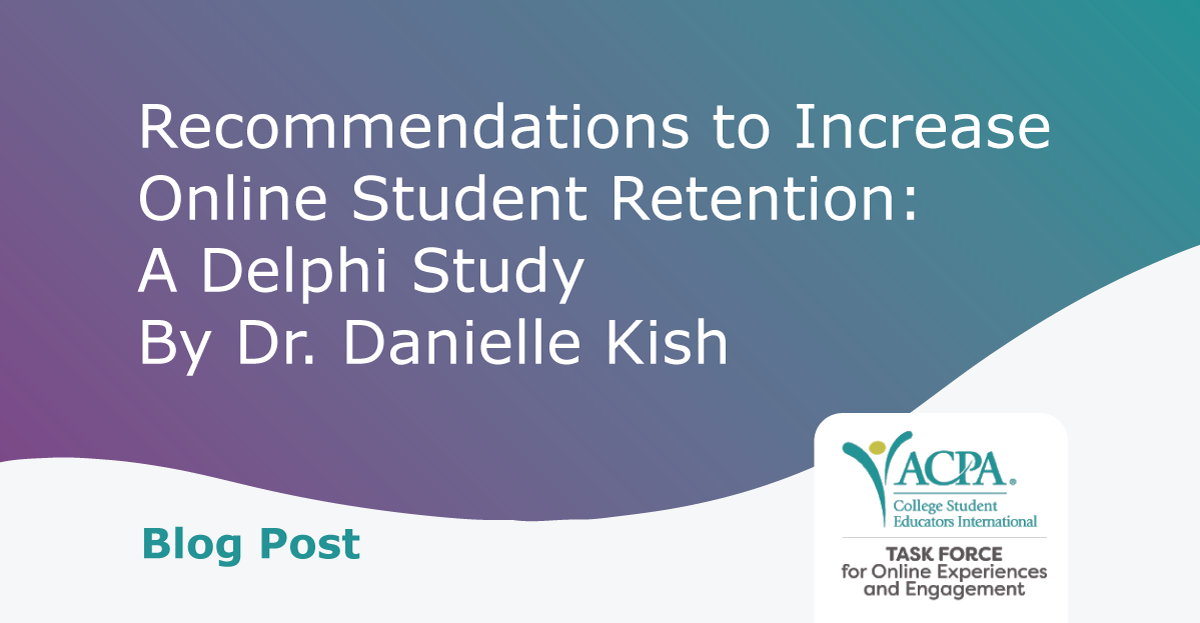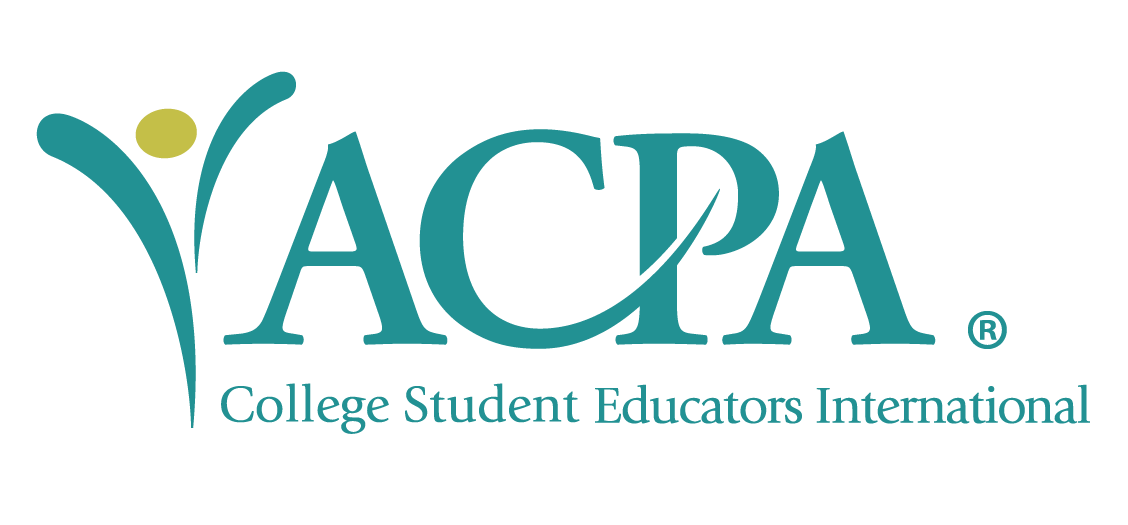
Recommendations to Increase Online Student Retention: A Delphi Study
By Dr. Danielle Kish
Higher education institutions (HEI), continue to see an increase in online courses as they gain in attendance and the National Center for Education Statistics (NCES, 2022) reported that by the fall of 2020, almost 75% of students were taking at least one course online. The increases in online courses were seen prior to the effects COVID-19 had on the college campus which saw many ground-campus courses become online courses. Online dropout rates continue to be a severe problem for HEI leaders as low retention rates continue (Muljana & Tian, 2019; Radovan, 2019). Nontraditional students make up over one-third of the undergraduate students in the U.S., and nontraditional online students have higher dropout rates in the first academic year than nontraditional students attending a ground-campus course/program (Ellis, 2019).
The U.S. Department of Education (2022) published a study in 2009 that indicated that students in an online environment performed better than students in a ground-campus course, yet to date online retention remains low. Technology continually evolves to increase collaboration among the online student population bringing students together in an environment that encourages students to support each other (Iyer & Chapman, 2021). Applying face-to-face technology, such as Zoom, provides positive effects in the classroom and preparation for online expectations (Argüello & Méndez, 2019; Kordrostami & Seitz, 2022; Radovan, 2019).
The transitional phase through socialization encompasses a student’s journey from the first thought of moving onto higher education to graduation and the overlap formed the conceptual framework for this study. Understanding the transitional phase that nontraditional students are moving through when returning to higher education can increase a student’s ability to adjust behaviors and relationships and be successful in the online classroom (Schlossberg, 1981). Increasing socialization on campus has the potential to increase online student retention through a transition phase, and the interconnectedness and commitment that students feel to the HEI staff, faculty, and students (Tinto, 1975; Bean & Metzner, 1985). Schlossberg (1981) explained that psychosocial competence revolves around a student’s psychological and social aspects of mental health and can be used to assist HEI’s staff and faculty in identifying when a student is struggling within the online environment.
The ability of the staff and faculty at an HEI to increase the human element through rapport building in the online environment may provide the social linkage that students need to succeed in the online course as already seen on the ground-campus (Glazier & Harris, 2020; Mays, 2022; Robertson, 2020). As a nontraditional student transitions to the online classroom, family support in addition to building rapport with the HEI faculty and staff may improve student success through socialization (Glazier & Harris, 2020; Kamer & Ishitani, 2021; Mays, 2022; Robertson, 2020). As a faculty member interacts with an online student by setting clear expectations (Iyer & Chapman, 2021) a student’s motivation and success may increase. The engagement between instructors and students online through class discussions, videos, and learning materials increases instructor-student socialization (Linden et al., 2022; Robertson, 2020; Tamir & Taylor, 2019). Students who are motivated may increase performance and retention while creating a higher quality of support (Ellis, 2019; Glenn, 2018; Marstellar & Bodzin, 2019; Nguyen, 2022; Radovan, 2019; Zhou & Wang, 2019).
The practices and expectations explained reflect the results and expectations for increasing student retention but do not provide specific guidelines and examples to assist leaders in HEIs. The purpose of the modified Delphi study was to gain a consensus from a group of educational experts who can identify best practices that have assisted in increasing retention among nontraditional online students. The 27 expert panelists were leaders, administrators, and faculty members (66%) with over five years of experience (57% had over 15 years of experience) working with online students from 15 different HEIs that offered online programs or courses. Round 1 asked the participants to identify all the best practices used to increase nontraditional online student retention.
Round 1 identified 46 best practices that were all used in Round 2. The Round 1 results were also thematically analyzed, and the four themes developed were Student & Administration, Faculty Engagement, Course Design & Technology, and HEI Overall. Panelists were asked to rate all 46 best practices using the Likert scale options of strongly agree, agree, disagree, and strongly disagree. The results of Round 2 were analyzed to identify the top eight best practices supported by the panel of educational experts. The top eight best practices were used in Round 3 and asked panelists to rank the eight best practices in the order it was believed the best practice would address the situational question. For example, which best practice would increase student retention, which best practice do the panelists believe the leaders at the HEI would enact, and which best practice is the most expensive? The results of Round 3 allowed for the best practices to be ranked and led to the recommendations offered.
The top eight best practices identified were (a) onboarding to ensure students have the knowledge needed to be successful in the classroom (standard deviation, SD,=.383), (b) verify the student has a computer and internet, not just a cell phone (SD=.383), (c) strong faculty members who have a good understanding of adult learners (SD=.428), (d) faculty empathy in understanding nontraditional student challenges (SD=.461), (e) proactive communication (SD=.461), (f) 24-hour technical support (SD=.461), (g) dedicated person(s) that students can reach out to for assistance outside traditional office hours of 8 am to 5 pm (SD=.461), (h) practice active listening (SD=.461).
Theme 1: Title of Theme 1 Recommendation
The eight best practices in conjunction with the four themes identified were used to form the recommendations to leaders and practitioners. Theme one reflects the relationships between students and administration. Theme one encompasses the transition to higher education for a nontraditional student and provides a student’s first step to socialization and building rapport with the staff at the HEI directly linked to the conceptual framework (Tinto, 1974; Schlossberg, 1981; Bean & Metzner, 1985). The administration staff (admissions and enrollment) should have a checklist of expectations that must be reviewed, verified, and signed by the student. The checklist should include onboarding items including does the student have a computer and internet access, can the student navigate the classroom or have the tools to understand the online environment, and the resources the student may need to be successful. If the student is struggling with any topics on the checklist further guidance and/or orientation courses should be assigned to the student prior to starting class.
Theme two, faculty engagement, is the focus of the second recommendation. Building rapport, positive communication, and engaging with students increases the student’s commitment to the course and may increase success through socialization efforts (Tinto, 1975; Bean & Mentzer, 1981, Glazier & Harris, 2020). To assist faculty with these expectations HEI leaders may institute a training course for faculty, specifically incoming faculty, inexperienced faculty, and faculty members who are experiencing low retention rates. This course should revolve around the actions that will assist with increasing online retention, for example reviewing the challenges of adult learners and identifying actions faculty may instill to provide support to this student population.
Twenty-four-hour technical support encompasses theme three, course design and technology. As HEI leaders increase the online course presence the ground campus day-to-day operational expenses may be lowered, and the budget shifted to the technical support for online environments (Kordrastami & Seitz, 2022). Twenty-four-hour technical support offers nontraditional online students support outside the traditional 8 am – 5 pm office hours and allows students to complete the coursework on the student’s schedule.
The final two recommendations revolve around theme four, HEI overall. First is active listening. Active listening should be taught to all HEI staff. Leaders can create active listening scenarios for role play dependent upon the division. The role play should be practiced within teams allowing team members to apply active listening strategies to an individual’s interaction with the student. The active listening strategies will further allow HEI staff to build socialization factors with the student and provide the HEI staff an opportunity to understand the student’s needs and provide the resources or guidance needed to overcome the student’s specific situation.
The final recommendation is for HEI leaders to bring in a dedicated person(s) to support students outside traditional office hours. Building and maintaining communication may be done virtually allowing for nontraditional students to feel connected to the HEI staff. The flexibility of HEI leaders to support students through student services, availability, and technical support has been shown to increase student retention (Muljana & Tian, 2019). All the recommendations revolve around the best practices and identified themes that were identified by the educational experts in the modified Delphi study.
As the attendance of nontraditional online students continues to grow, the need to identify best practices and recommendations to improve retention will increase. The recommendations identified by this study for leaders and practitioners include a comprehensive checklist of student expectations during admissions, training courses for faculty and staff, and support for students outside traditional office hours. These best practices and recommendations should serve as a launchpad in the effort to bridge the gap in research and practices related to increasing nontraditional online student retention.
Biography
Danielle Kish, EdD, is the founder of College Questions an organization dedicated to assisting students and their families transition into higher education and providing student support to increase student success. Danielle spent 13 years working with online students regarding enrollment and retention at the University of Phoenix (UOPX) and was the Fall 2021 Fellow at the Council for Higher Education Accreditation (CHEA) in Washington, D.C.. Danielle completed her doctorate in Education (EdD) at UOPX in February 2023, her dissertation is entitled Understanding Online Retention in Nontraditional Higher Education Students: A Delphi Study
References
Argüello, G., & Méndez, M. G. (2019, April 1). Virtual Advising: A Tool for Retention, Engagement, and Success for the Graduate Distance Learner. Distance Learning, 16(2), 51.
Bean, J. P., & Metzner, B. S. (1985). A conceptual model of nontraditional undergraduate student attrition. Review of Educational Research, 55, 485-540.
Ellis, H. (2019). A nontraditional Conundrum: The dilemma of nontraditional student attrition in higher education. College Student Journal, 53(1), 24.
Glazier, R. A., & Harris, H. S. (2020). How teaching with rapport may improve online student success and retention: Data from two empirical studies. Quarterly Review of Distance Education, 21(4), 1-17.
Glenn, C. W. (2018). Adding the human touch to asynchronous online learning. Journal of College Student Retention: Research, Theory & Practice, 19(4), 381-393. https://doi.org/10.1177/1521025116634104
Iyer, D. G., & Chapman, T. A. (2021). Overcoming technical inequity in synchronous online learning. Communications of the Association for Information Systems, 48, 205-212. https://doi.org/10.17705/1CAIS.04826
Kamer, J. A., & Ishitani, T. T. (2021). First-year, nontraditional student retention at four-year institutions: How predictors of attrition vary across time. Journal of College, Student Retention: Research, Theory & Practice 23(3), 560-579. doi:10.1177/1521025119858732
Kordrostami, M., & Seitz, V. (2022). Faculty online competence and student affective engagement in online learning. Marketing Education Review, 32(3), 240-254. https://doi.org/10.1080/10528008.2021.1965891
Linden, K., Teakel, S., & der Pleog, N. V. (2022). Improving student success with online embedded tutor support in first-year subjects. A practice report. Student Success, 13(2), 42-50. https://doi.org/10.5204/ssj.2338
Marsteller, R., & Bodzin, A. (2019) Examining the implementation of an online curriculum designed with the person theoretical framework on student’s evidentiary reasoning and self-regulated learning. Electronic Journal of Science Education, 23(3), 73-95.
Mays, T., & Ross, S. (2022). Sense of community in synchronous and asynchronous online courses: Perceptions and experiences of nontraditional students. Online Journal of Distance Learning Administration, 25(1), 1-16.
Muljana, P. S., & Tian, L. (2019). Factors contributing to student retention in online learning and recommended strategies for improvement: A systematic literature review. Journal of Information Technology Education, 18, 19-43. https://doi.org/10.28945/4182
Muir, T., Douglas, T., & Trimble, A. (2020). Facilitation strategies for enhancing the learning and engagement of online students. Journal of University Teaching & Learning Practice, 17(3). 1-17.
National Center for Education Statistics (2022). Fast facts: Distance learning. Retrieved from: https://nces.gov/fastfacts/display.asp?id=80
Nguyen, N. B. C. (2022). Improving online learning design for employed adult learners. Proceedings of European Conference on E-Learning, 302-309. https://doi.org/10.34190/ecel.21.1.554
Radovan, M. (2019). Should I stay, or should I go? Revisiting student retention models in distance education. Turkish Online Journal of Distance Education (TOJDE), 20(3), 29-40.
Robertson, S. G. (2020) Factors that influence students’ decision to drop out of an online business course (Order No. 27739497). Available from ProQuest Dissertations & Thesis Global. (2379726960). https://www.proquest.com/dissertations-theses/factors-that-influence-students-decision-drop-out/docview/2379726960/se-2
Schlossberg, N. K. (1981). A model for analyzing human adaption to transition. The Counseling Psychologist, 9(2), 2-18. https://doi.org/10.1177/001100008100900202
Tamir, O., & Taylor, N. (2019). Nontraditional students: Understanding and meeting their needs in the anthropology classroom. Teaching and Learning Anthropology, 2(2), 25-40.
Tinto, V. (1975). Dropout from higher education: A theoretical synthesis of recent research. Review of Educational Research, 45, 89-125.
U.S. Department of Education (2022). Retrieved from https://search.usa.gov/search?utf8=%E2%9C%93affiliate=ed.gov&query=first+year+retention
Zhou, Y., & Wang, J. (2019). Goal orientation, learning strategies, and academic performance in adult distance learning. Social Behavior & Personality: An International Journal, 47(7), 1-20. https://doi.org/10.2224/sbp.8195
ACPA Online Experiences & Engagement Task Force provides opportunities for professional development about contemporary issues in engaging college students beyond coursework and creating meaningful experiences in a virtual space.



Recent Comments